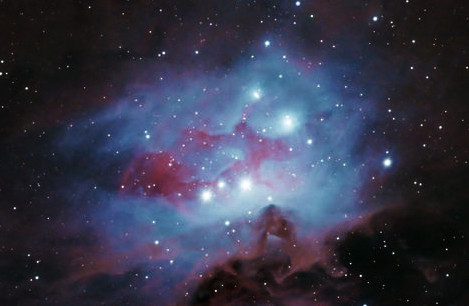Cepheus nebulae (Southern region)
Constellation: Cepheus
This is a mosaic composed of 30 panes as well as several images covering the Lion nebula, the Elephant’s Trunk nebula and its surroundings, the Flying bat and Squid nebulae (also known as OU4), the Seahorse nebula as well as the galaxy NGC 6946 region. It covers a region over 18° from east to west.
Telescope & Mount:
Different telescopes were used for this image:
- Celestron 9.25″ EdgeHD with Hyperstar 4.0 on a 10Micron GM1000HPS mount.
- Takahashi FSQ-106ED on a Paramount MX+ mount.
- Orion Optics UK ODK10 on a 10Micron GM1000HPS mount.
- Takahashi Epsilon 180 F/2.8 Astrograph on a Paramount MX mount.
Imaging:
Several cameras were used:
- ZWO ASI2600MC-Pro
- ZWO ASI2600MM-Pro
- ZWO ASI1600MC-Pro
Data:
Combination of color and narrow band (Hydrogen-α and Oxygen-III) images.
Total integration time: 85h 14′
The Flying bat and Squid nebulae.
The Flying bat nebula (also known as Sh2-129) is a bright nebula in the constellation Cepheus at a distance of 9318 Ly from Earth. At the heart of the nebula is another nebula, often referred to as the Squid nebula (Ou4). This O-III emitting nebula was recently discovered by the French amateur astrophotographer Nicolas Outters in 2011. Recent research seems to indicate that Ou4 is indeed located within Sh2-129. It is assumed that the nebula is getting it’s energy from a strong outflow from HR8119, a triple star system right in the middle of the Squid nebula. To its west, one can find the dark Seahorse nebula, as well as the the Fireworks galaxy (NGC 6946) and the open cluster NGC 6939 (North of NGC 6946). Link to interactive sky chart.
Sh2-129 with Ou4 with a 56′ trail left by Comet C/2023 E1 (ATLAS). The image was taken with a Takahashi E130 F/3.3 between July and August 2023. The image is in Ha, Oiii and Sii with RGB stars. Total integration time is 21h 15′.
There were 18 frames taken between August 5 (22:48) and 6 (00:44) were showing a fast moving and very faint object that turned out to be C/2023 E1 (ATLAS). These frames were integrated separately and the image overlayed on top of the main image.



